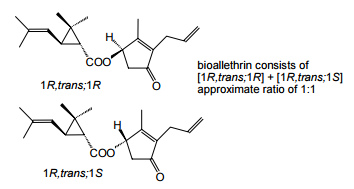Bioallethrin 生物烯丙菊酯
Introduction: Bioallethrin is a a pyrethroid ester insecticide used mainly in domestic situations such as houses, officies and industrial sites to control of house flies, mosquitoes, wasps, hornets and cockroaches.
Common name: Bioallethrin
Another name: Depalléthrine ((f) France, AFNOR); d-trans-allethrin (ESA).
Chemical name: (RS)-3-allyl-2-methyl-4-oxocyclopent-2-enyl (1R)-trans-2,2-dimethyl-3-(2-methylprop-1-enyl)cyclopropanecarboxylate
Empirical formula: C19H26O3
Structural formula:

Mol. Weight: 302.40794 g/mol
CAS No.: 584-79-2
Specifications
Leading Bioallethrin supplier
Bioallethrin 93% TC
Packing:
BULK PACKING
Liquid: 200L/Drum, 20L/Drum, 10L/Drum ect.
SMALL PACKING
Liquid: 5L/Drum, 1L/Bottle, 500ml/Bottle, 250ml/Bottle, 100ml/Bottle, 50ml/Bottle etc.
Customerized Packing label
Bioallethrin FAO standard
Professional registration
HAZARDS IDENTIFICATION
Hazard statement(s)
H302: Harmful if swallowed.
H332: Harmful if inhaled.
H410: Very toxic to aquatic life with long lasting effects.
Precautionary statement(s)
P261: Avoid breathing dust/fume/gas/mist/vapors/spray.
P264: Wash ... thoroughly after handling.
P270: Do not eat, drink or smoke when using this product.
P271: Use only outdoors or in a well-ventilated area.
P273: Avoid release to the environment.
P301+P312: IF SWALLOWED: call a POISON CENTER/doctor/... IF you feel unwell.
P304+P312: IF INHALED: Call a POISON CENTER/doctor/... if you feel unwell.
P312: Call a POISON CENTER or doctor/... if you feel unwell.
P330: Rinse mouth.
P391: Collect spillage.
P501: Dispose of contents/container to ...
Supplemental Hazard Statements: none
MAMMALIAN TOXICOLOGY
Acute toxicity: 1) Acute oral LD50 for rat: 709 a.i.mg/kg. 2) Acute dermal LD50 for rat: >3000 a.i.mg/kg. 3) Inhalation LC50 (4 h) for rat: 2.5 a.i. mg/L. 4) Slightly- irritating to skin (rabbits). 5) Mildly- irritating to eyes (rabbits). 6) Not a skin sensitiser (guinea pigs). There was no evidence of carcinogenicity and genotoxic. Bioallethrin has no effect on fertility parameters nor on foetal or infant development.
ADI: 0.005mg/kg b.w.
Classification:
Toxicity class WHO (a.i.): II (Moderately hazardous)
US EPA Classification (formulation): III (Caution - Slightly toxic)
EC Risk Classification: Xn - Harmful: R20/22; N - Dangerous for the environment: R50, R53
ECOTOXICOLOGY
Effect on birds: low toxicity to birds, acute oral LD50 for Bobwhite quail >2030 a.i.mg/kg. Effect on fish: high toxicity to fish, acute 96 hour LC50 for sunfish is 0.024 a.i.mg/L. Effect on aquatic invertebrates: high toxicity to aquatic invertebrates, acute 48 hour EC50 for Daphnia magna is 0.0356 a.i.mg/L. Effect on honeybees: moderate toxicity to honeybees, contact acute 48 hour LD50 is 3.4 a.i.μg/bee.
ENVIRONMENTAL FATE
Animals: [14C-acid]-bioallethrin administered in rats with a single dose of either 200 or 100 mg/kg b.w. was readily eliminated in the urine and faeces of all dose groups within 2-3 days after treatment.
Soil/Environment: [14C-alcohol]-bioallethrin degrades in pH 5 buffer to allethrolene, dihydroxyallethrolene, CO2 and a number of small yield polar products as the result of photochemical processes. Cis/trans isomerisation was not observed. The actual and extrapolated DT50 of light-exposed and dark control samples is 48.8 h and 1447 h, respectively.
Usage: Bioallethrin was first made by Roussel-Uclaf in France. J. Lhoste first announced his biometric results in 1967. Bioallethrin is mainly used to control household insects.
Application: Non-systemic, non-residual insecticide with contact and stomach action. Has rapid knockdown activity. Bioallethrin is 1.1-1.2 times as effective as d-allehtrin and is mainly used to control household insects. Bioallethrin is formulated as aerosols and sprays with synergists or other insecticides(e.g. d-phenothrin or deltamethrin). Bioallethrin main formulation type available is MV(vaporizing mat) and MC(mosquito coil).
| 






